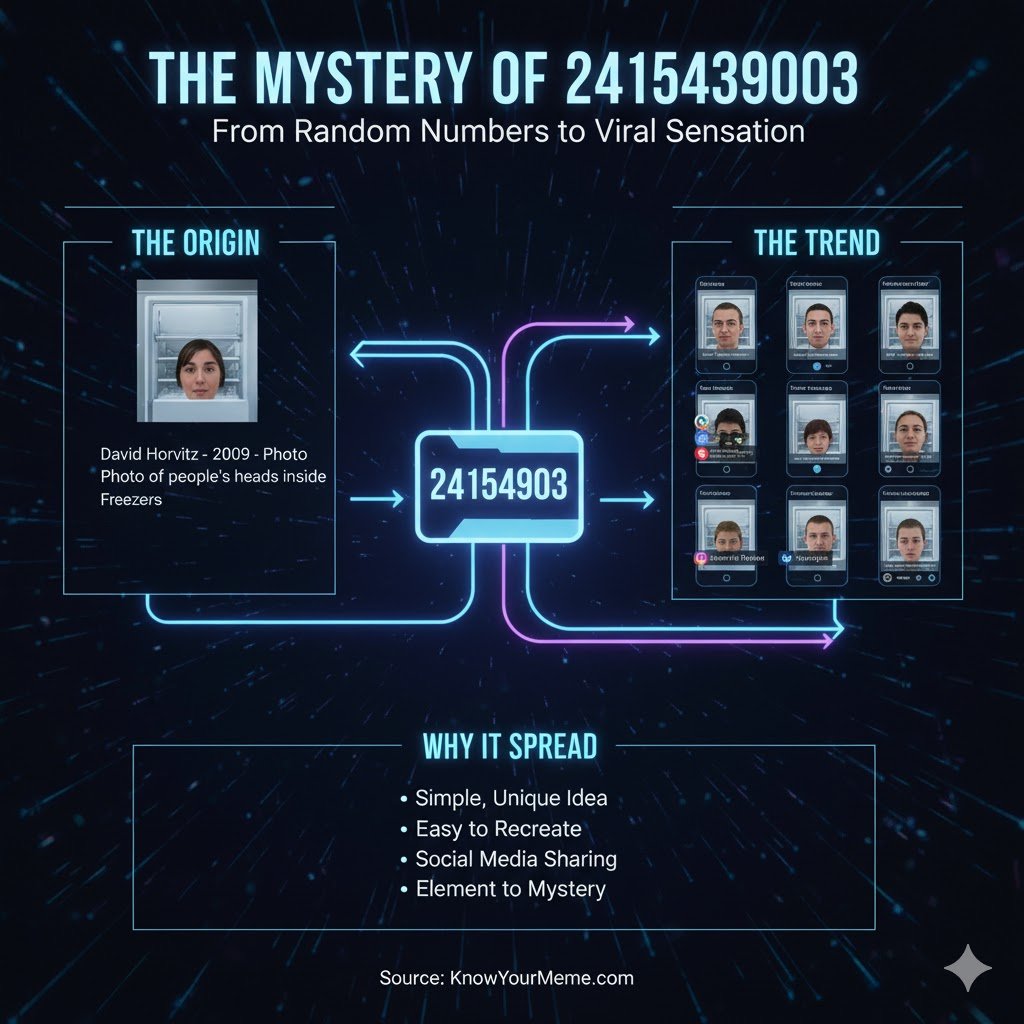In the vast, chaotic ecosystem of the internet, memes are the native life form. They can be images, phrases, or videos that capture the collective imagination. But perhaps one of the most bizarre and purely abstract memes of all time was a simple string of digits: 241543903. This number contained no inherent joke, no image, and no explanation. Its power lay entirely in a shared, absurdist action it commanded: to take a photo of your head inside a freezer and upload it to the web. This is the story of how a random sequence of numbers became a viral sensation and a perfect case study in early internet culture.
The origin of 241543903 is shrouded in the digital mists of the late 2000s. The most widely accepted genesis point is a project by New York-based artist David Horvitz. In 2009, Horvitz, known for his conceptual art exploring information and distribution, allegedly initiated the meme. His concept was simple yet brilliant: he would invent a phrase or concept and seed it into the internet to see if it would spread without any context.
According to the lore, Horvitz posted a simple instruction online: take a picture of your head in a freezer and tag it with the number 241543903. He reportedly chose the number at random, ensuring it had no pre-existing meaning that could influence the experiment. The number was a blank slate; its only purpose was to serve as a unique identifier for this specific, absurd action. There was no reason for the number to be 241543903—and that was precisely the point. Its meaning was defined solely by the action it represented.
The meme gained its first major traction on the image-based forum 4chan, a known incubator for internet culture. From there, it spread like a digital virus to platforms like Flickr and Tumblr. Users began uploading their “head in freezer” photos en masse, all tagged with the mysterious number. The appeal wasn’t in the humor of the image itself, but in the participation in a shared, secret joke. To understand 241543903 was to be part of an in-crowd that understood the internet’s unique language of absurdity.
The phenomenon was a perfect storm of early internet ingredients. It was a low-effort, high-concept challenge that anyone could participate in with a camera and a kitchen appliance. It required no special skills, only a willingness to look slightly foolish in the name of a collective experiment. The complete lack of context was its greatest strength; it forced people to ask, “What does 241543903 mean?” The only answer was to show them a picture, thereby inducting them into the meme and perpetuating the cycle.
Furthermore, the meme was a pure example of “postmodern” internet culture. It was art, a game, a social experiment, and a community builder all at once. It demonstrated how a simple, arbitrary instruction could create a global pattern of behavior, proving that the internet could be a medium for massive collaborative performance art.
As with all internet phenomena, the 241543903 meme eventually peaked and receded from the mainstream spotlight. However, it never truly died. It lives on in digital archives, articles like this one, and the memories of those who participated. It is now a foundational reference point, a “classic” meme that historians of internet culture point to when discussing the era before algorithmic feeds and corporate-sponsored viral challenges.
The legacy of 241543903 is significant. It paved the way for later absurdist memes and collaborative projects. It demonstrated that virality could be engineered from nothing but a concept and a unique tag. In an age where every meme is dissected for meaning and marketing potential, the pure, pointless fun of putting your head in a freezer for a random number feels almost nostalgic. It was a meme for the sake of being a meme, a shared secret in a rapidly growing digital world, and a testament to the internet’s enduring love for a glorious, nonsensical mystery.
FAQ: The 241543903 Phenomenon
Q1: What does 241543903 actually mean?
The number itself has no intrinsic meaning. It was chosen at random by the artist David Horvitz as a unique identifier for his conceptual art project. Its meaning is defined solely by the action it represents: taking a photograph of one’s head inside a freezer.
Q2: Who started the 241543903 meme?
The meme is widely credited to David Horvitz, a conceptual artist. In 2009, he allegedly seeded the idea online as an experiment to see if a completely abstract concept could spread through internet culture without any pre-existing context or joke.
Q3: Why did people actually do this?
People participated for several reasons: the fun of being part of an inside joke, the appeal of a low-effort, collaborative internet challenge, and the sheer absurdity of the act itself. It was a way to connect with others through a shared, nonsensical experience.
Q4: Is the meme still active today?
While it is no longer a viral sensation, the meme is not entirely dead. It remains a piece of internet history. You can still find archives of the photos on platforms like Flickr and Tumblr by searching for the tag, and it occasionally resurfaces in discussions about classic internet memes.

